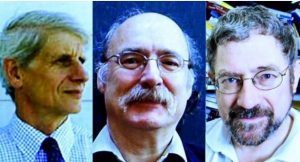Nobel Prize in Physics 2016 won by 3 British scientists

Three British-born scientists won the 2106 Nobel Prize in Physics, for discoveries about strange forms of matter.
David Thouless, Duncan Haldane and Michael Kosterlitz, will share £727,000 ( 8m Kronor) prize.
Their work could benefit improved materials for electronics including super-fast computing.
The winners will join an elite list of 200 other Physics laureates recognised since 1901.
“They have opened the door on an unknown world” according to the Nobel Committee.
Matter in extreme conditions such as when it’s very cold or flat, scientists start to see unusual behaviour from the atoms. These Phenomena is in line with the familiar phases of matter when things change from solid to liquid to gas. They used maths to explain strange physical effects in extreme states of matter, as superconductors, super-fluids and thin magnetic films. They also focused on the phenomena that arise in flat forms of matter on surfaces or inside extremely thin layers that can be considered two-dimensional. Prof Cooper said “ scientists are exploring whether topological concepts could be used in robust quantum devices which can do things that classical computers or classical circuit elements are unable to do. Microsoft’s Station Q project is going beyond the development of powerful quantum computers. The topological aspects can give the quantum information a robustness against being destroyed by the usual noisy environment Topological metals could be used in the manufacture of improved conductors and transistors.
Professor Haldane said: “I was very surprised and very gratified.”
